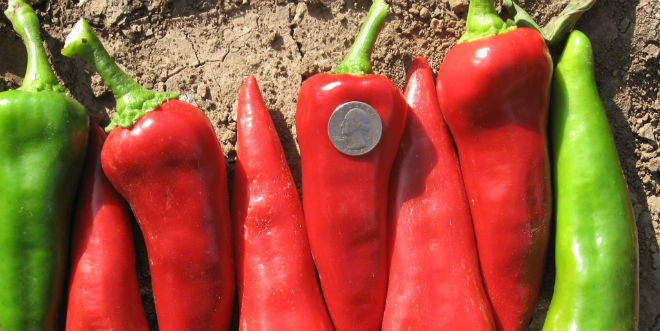

Sep 11, 2017‘Luck,’ patience yield new Pueblo chile variety
A new variety of Pueblo Mirasol chile pepper with fleshier fruit for grilling has been developed in Colorado, where it’s growing in popularity.
Michael Bartolo, a researcher with the Colorado Fruit and Vegetable Growers Association, worked on the Mosco variety for 25 years as a side project to his regular work. He used the single-plant selection technique, allowing open cross-pollination to take place rather than intentionally creating a hybrid variety.
“It was a lot more luck than anything else,” Bartolo said. “You never know quite what you’re going to find.”


Mirasol is Spanish for “looking at the sun,” referring to the way it grows with peppers upright. The pepper originated in Mexico, but was brought to the United States and improved by horticulturalist Fabian Garcia.
Mirasol Pueblo chiles have been grown in southern Colorado for roughly 100 years, according to Bartolo, and remain very popular with growers and residents there, especially the state’s Arkansas Valley area.
Bartolo’s project to create a new variety started with the seeds he took in in the early 1990s from the Arkansas Valley property of his late uncle, Harry Mosco.
“His family, and mine, were longtime growers,” he said. The families were Italian-American, and Mosco remembers that Pueblo chiles were used in sausage that they cooked.
“It’s part of the social fabric of these communities,” he said. “Food isn’t just calories.”
Bartolo persisted for three to four generations of chiles, using single-plant selection, before it became apparent that the project had potential. Later generations of peppers gained a genetic consistency, and he has continued to breed for improved agricultural traits, yield, hardiness and ease of picking.
Compared to a typical long green Anaheim pepper, the Pueblo Mosco has a more pungent, fruity taste, by Bartolo’s description. It’s estimated at 5,000 to 6,000 Scoville units – less heat than a jalapeno, but more than an Anaheim pepper.
Bartolo said the Mosco variety has become more popular among growers in Colorado’s Arkansas Valley, where a few hundred acres of Pueblo peppers are grown each year.
“We’re looking more or less at a type of specialty arena,” he said. He currently has about 100 different lines of the peppers in the breeding program.
Shane Milberger of Milberger Farms in Pueblo said the region is crazy about Pueblo chiles, of which he says the Mosco variety is the best representation. Milberger himself has a retail outlet and a restaurant themed around the Pueblo chile.
Milberger said he gets orders from individual customers in other states – transplants from Colorado who want the chiles to which they are accustomed.
“They know what it is. They know what a chile is supposed to taste like,” he said. “It has such a unique flavor and heat to it.”
Bartolo has a doctorate degree in plant physiology from the university of Minnesota, and while developing the Mosco variety he had access to facilities at Colorado State University’s Arkansas Valley Research Station. But he doesn’t discourage others from trying to develop new varieties on their own.
“Sometimes you can develop things that are uniquely adapted to your area,” he said.
— Stephen Kloosterman, assistant editor














